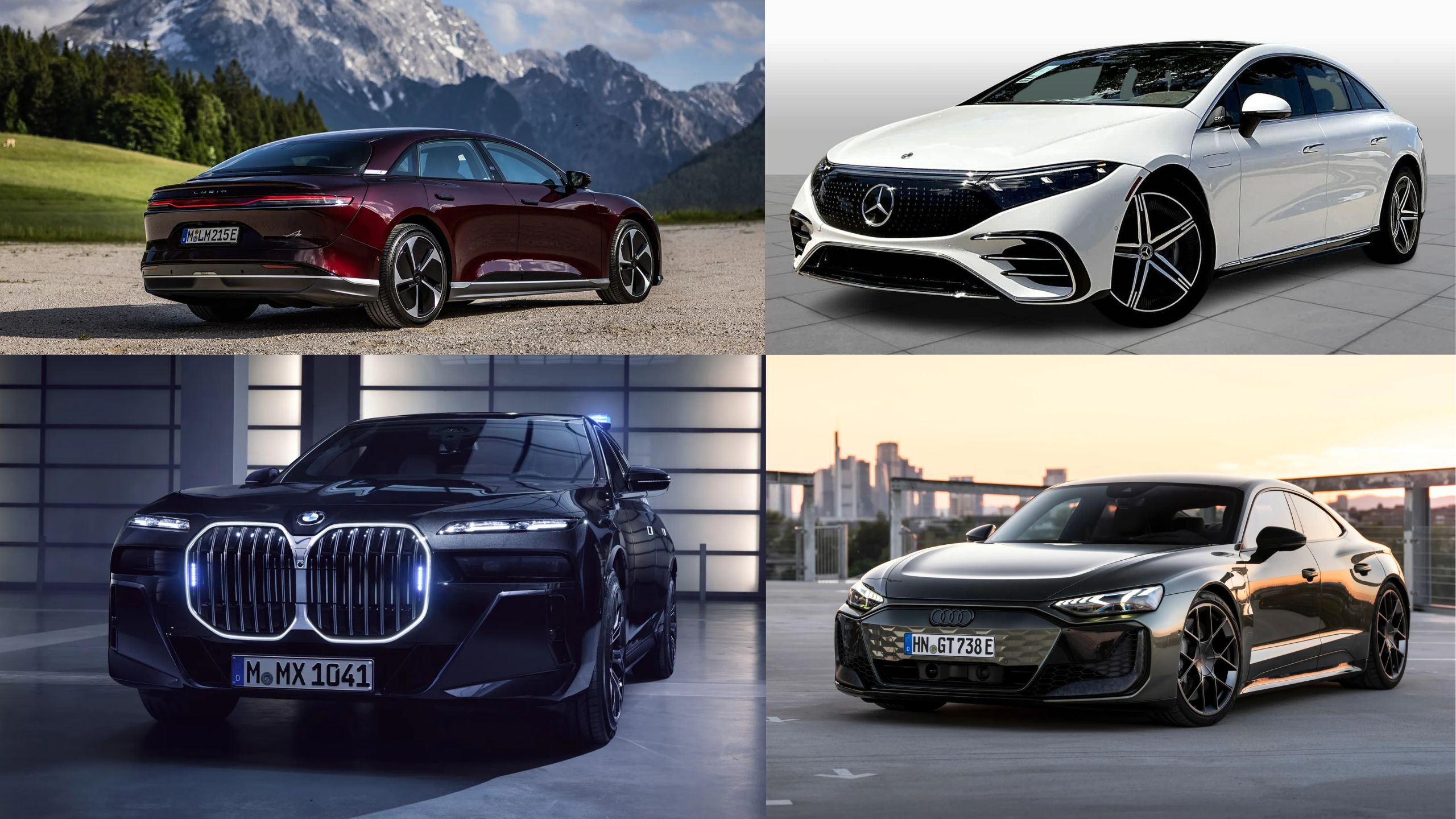In the rapidly evolving automotive world, luxury electric sedans have emerged as formidable competitors to their gas-powered counterparts.
These sophisticated EVs combine opulent interiors, cutting-edge technology, and exhilarating performance while delivering zero tailpipe emissions.
The luxury EV market has matured significantly, offering discerning buyers vehicles that no longer require compromise instead, they often exceed traditional luxury vehicles in acceleration, quietness, and innovative features.
From established luxury automakers like Mercedes-Benz and BMW who have embraced electrification to disruptive newcomers like Tesla and Lucid that have reimagined what a premium sedan can be, today’s electric luxury options are diverse and compelling.
These vehicles typically feature extended range capabilities, ultra-fast charging technologies, and interior experiences that blend traditional craftsmanship with futuristic interfaces.
The following twelve luxury electric sedans represent the pinnacle of automotive innovation, offering environmental benefits without sacrificing the performance, comfort, and prestige expected in this premium segment.
Each combines distinctive styling, advanced driver assistance systems, and refined driving dynamics that make them worthy alternatives and in many cases, superior choices to their combustion-engine rivals.
1. Tesla Model S
The Tesla Model S continues to set the standard for luxury electric sedans, having pioneered the segment over a decade ago.
In its latest iteration, the Model S offers breathtaking performance with the Plaid variant accelerating from 0-60 mph in under 2 seconds making it one of the quickest production cars ever made.
This remarkable acceleration comes courtesy of a tri-motor setup delivering over 1,000 horsepower to all four wheels. Beyond raw speed, the Model S provides a range of up to 405 miles on a single charge, alleviating the range anxiety that once plagued electric vehicles.
Its minimalist interior centers around a 17-inch world-oriented touchscreen that controls nearly all vehicle functions, complemented by a second screen for rear passengers. The yoke-style steering wheel remains a polarizing but distinctly futuristic feature.
Tesla’s Supercharger network remains a significant advantage, offering convenient fast-charging stations across North America, Europe, and Asia.
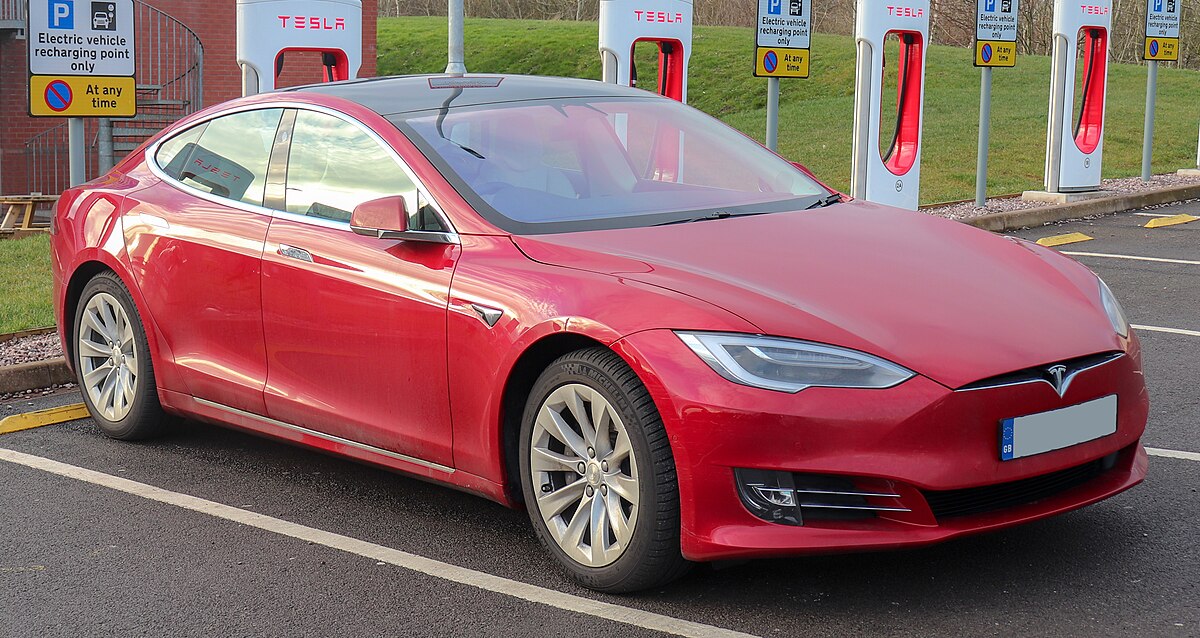
The automaker’s over-the-air update capability means the Model S continues to evolve even after purchase, with new features and refinements regularly added to the vehicle’s software.
The Model S’s adaptive air suspension provides a comfortable ride while maintaining precise handling, striking a balance between luxury cruiser and sports sedan.
Advanced driver assistance features, including the controversial but capable Full Self-Driving package, push the boundaries of automotive technology, though they still require driver supervision.
While traditional luxury automakers have caught up in many aspects, the Model S remains a technological tour de force that combines extraordinary performance, cutting-edge features, and electric efficiency in a package that continues to influence the entire automotive industry.
2. Lucid Air
The Lucid Air represents a quantum leap in electric vehicle engineering, developed by a team led by former Tesla chief engineer Peter Rawlinson.
This newcomer to the luxury sedan market has quickly established itself as a premium contender with industry-leading specifications and refined execution.
The flagship Lucid Air Dream Edition offers an EPA-estimated range of up to 520 miles the longest of any electric vehicle currently available thanks to its incredibly efficient powertrain and aerodynamic design.
Its dual-motor setup produces up to 1,111 horsepower in Performance trim, enabling 0-60 mph acceleration in just 2.5 seconds while maintaining remarkable energy efficiency.
Inside, the Air presents a refreshingly different take on luxury, with a floating 34-inch curved glass cockpit display complemented by a retractable central touchscreen.
Materials throughout the cabin exemplify thoughtful luxury, incorporating sustainable elements like alpaca wool, recycled yarns, and responsibly sourced wood. The expansive glass canopy creates an airy atmosphere that enhances the already generous interior space.
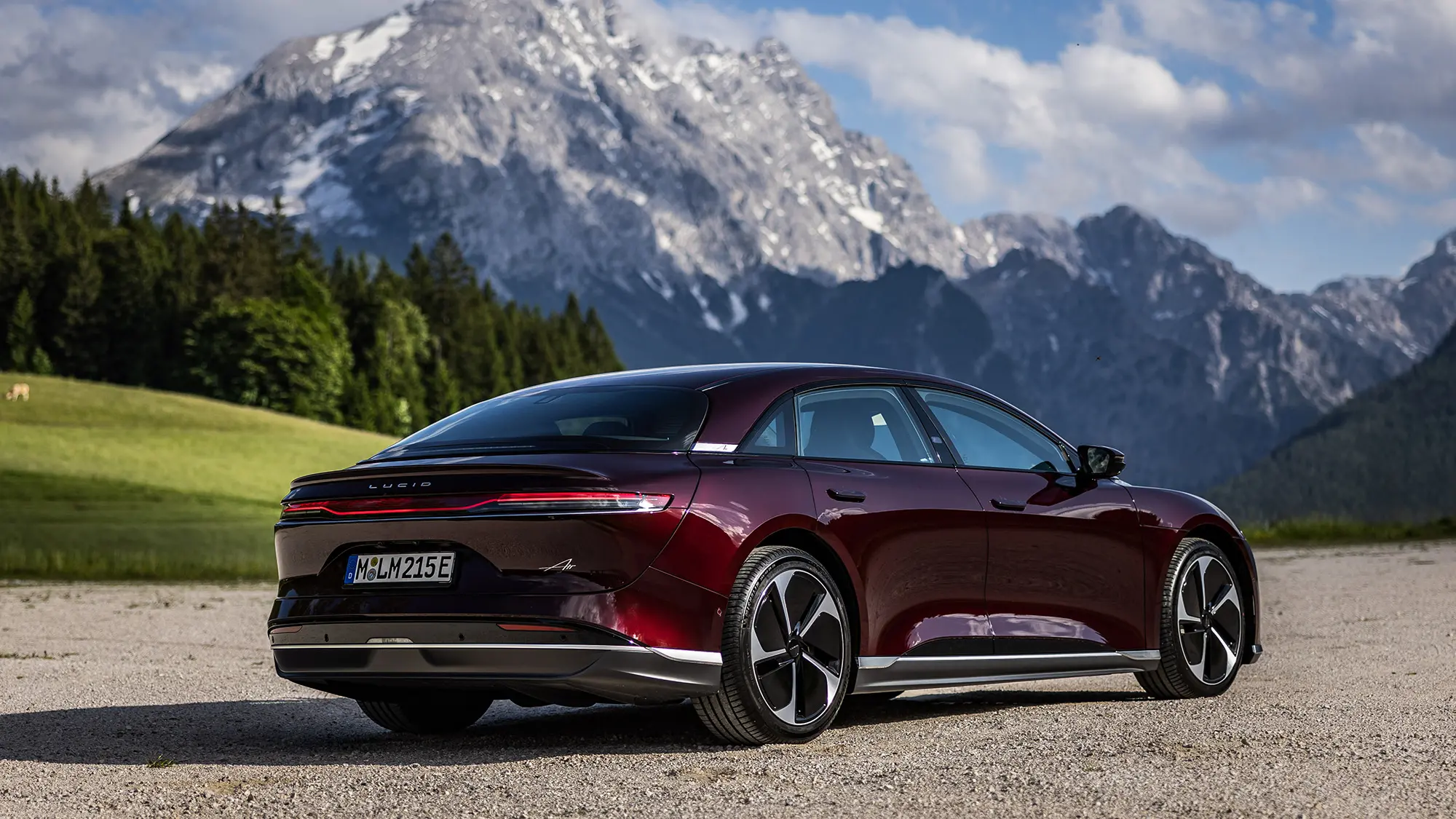
Lucid’s proprietary 900+ volt electrical architecture enables ultra-fast charging, adding up to 300 miles of range in just 20 minutes at compatible DC fast chargers.
The company’s vertical integration designing its motors, inverters, and battery packs in-house has allowed for optimized packaging that maximizes interior space while maintaining a sleek exterior profile.
The Air’s driving dynamics strike an impressive balance between comfort and sportiness, with an adaptive suspension system that can analyze road conditions and adjust accordingly.
Its DreamDrive Pro advanced driver assistance system incorporates 32 sensors, including high-resolution LIDAR, setting the stage for enhanced safety and future autonomous capabilities.
While Lucid faces the challenges of being a new manufacturer, including production ramp-up issues and establishing a service network, the Air’s exceptional engineering and attention to detail make it a compelling alternative to established luxury sedan offerings.
3. Mercedes-Benz EQS
The Mercedes-Benz EQS represents the storied German manufacturer’s vision for luxury electric transportation, serving as the battery-powered counterpart to the legendary S-Class.
This flagship electric sedan embodies the brand’s century-plus of luxury expertise while embracing a forward-looking, aerodynamic design that achieves a remarkable drag coefficient of just 0.20 making it one of the most aerodynamically efficient production vehicles ever created.
At the heart of the EQS experience is the optional MBUX Hyperscreen, a breathtaking 56-inch curved glass panel housing three integrated displays that span the entire dashboard.
This technological showcase enables intuitive control of vehicle functions while dazzling occupants with stunning graphics and responsive interfaces. The artificial intelligence-powered system learns driver preferences over time, proactively offering suggestions based on habits and routines.
The EQS delivers the whisper-quiet, supremely comfortable ride quality Mercedes-Benz is renowned for, with an advanced air suspension system that anticipates road imperfections using a forward-facing camera.
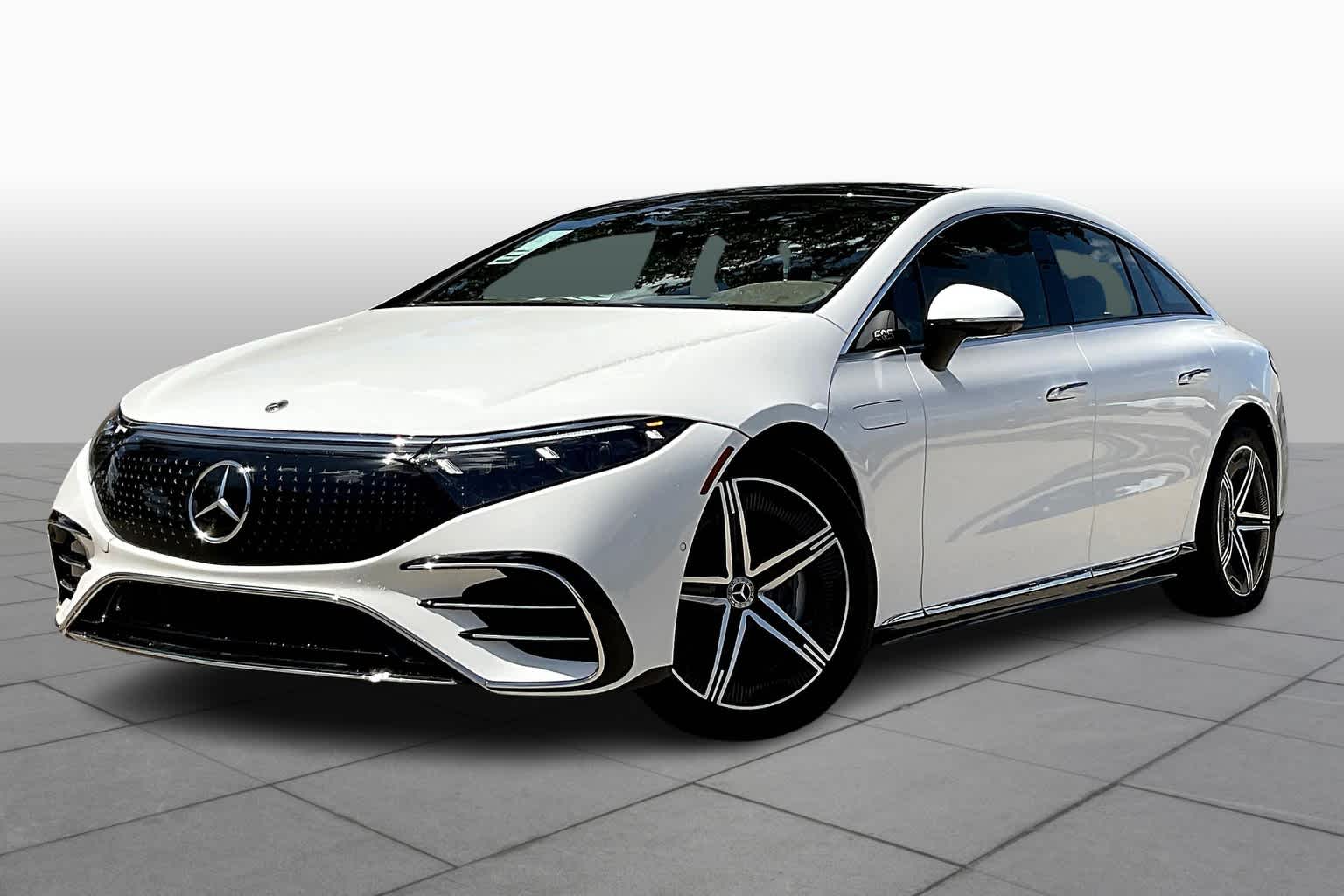
Available rear-wheel steering allows the large sedan to maneuver with unexpected agility in tight spaces, reducing its turning circle to that of many compact cars.
Power comes from either a single-motor rear-wheel drive setup or a dual-motor all-wheel drive system, with the performance-oriented EQS 580 producing 516 horsepower and accelerating to 60 mph in approximately 4.1 seconds.
The substantial 107.8 kWh battery provides up to 350 miles of range while supporting 200 kW DC fast charging, adding 186 miles in just 19 minutes under optimal conditions.
Mercedes has crafted an interior that balances technological innovation with traditional luxury, incorporating sustainable materials like responsibly sourced wood and recycled plastics without compromising the sumptuousness expected in a vehicle of this caliber.
The comprehensive ambient lighting system with 64 colors transforms the cabin atmosphere, while the optional 710-watt Burmester 3D sound system delivers exceptional audio quality.
For buyers seeking electric transportation without compromise, the EQS delivers the brand’s hallmark luxury and engineering excellence in a package that embraces the possibilities of electric propulsion while maintaining Mercedes-Benz’s distinctive character.
4. BMW i7
The BMW i7 represents the Bavarian automaker’s bold statement in the ultra-luxury electric segment, serving as the battery-powered flagship alongside the traditional 7 Series.
Rather than developing a dedicated electric platform, BMW has created a versatile architecture that accommodates both internal combustion and fully electric powertrains, allowing the i7 to maintain the proportions and presence of its conventional counterpart.
This approach results in a commanding sedan with distinctive styling highlighted by BMW’s illuminated kidney grille, which features an elegant cascade lighting effect.
The i7’s imposing dimensions house a truly palatial interior that prioritizes rear-seat luxury, offering an optional 31.3-inch 8K Theater Screen that descends from the ceiling, transforming the back seats into a mobile cinema complete with built-in Amazon Fire TV functionality and an upgraded Bowers & Wilkins Diamond Surround Sound System with up to 36 speakers.
Power comes from a dual-motor setup generating 536 horsepower in the i7 xDrive60 and a formidable 650 horsepower in the performance-oriented i7 M70.
The latter accelerates from 0-60 mph in just 3.5 seconds extraordinary performance for a vehicle weighing nearly three tons. The 101.7 kWh battery provides approximately 300 miles of range while supporting DC fast charging at up to 195 kW, adding 80 miles in about 10 minutes under optimal conditions.

The i7’s highway assistant allows for hands-free driving at speeds up to 85 mph on pre-mapped highways, while the available parking assistant professional can remember up to 10 different parking maneuvers including complex parking garage scenarios executing them automatically when requested.
The “Great Entrance Moments” feature orchestrates a choreographed welcome sequence of lights and automatically opening doors as the driver approaches.
BMW has maintained its driver-focused philosophy despite the i7’s considerable luxury. The adaptive air suspension combined with active roll stabilization delivers surprising agility for such a large vehicle, while the near-silent electric powertrain enhances the sense of refinement.
Selectable driving sounds composed by film score composer Hans Zimmer provide a futuristic acoustic experience that increases in intensity with more spirited driving.
The i7 successfully translates BMW’s distinctive character to the electric era, offering a compelling alternative for discerning luxury buyers who seek both cutting-edge technology and traditional craftsmanship in an environmentally conscious package.
Also Read: 10 Off-Roading Mods That Are Legal in Most States
5. Porsche Taycan
The Porsche Taycan has definitively proven that electrification and driving enthusiasm can coexist harmoniously. This groundbreaking sedan translates Porsche’s sports car DNA into the electric age without compromise, establishing itself as one of the most engaging and driver-focused EVs on the market.
Unlike many electric vehicles that prioritize straight-line acceleration above all else, the Taycan excels in dynamic balance. Its low-slung battery placement creates a center of gravity even lower than the iconic 911, while the sophisticated chassis tuning delivers the precision handling Porsche is legendary for.
The Taycan’s steering offers exceptional feedback for an electric vehicle, connecting the driver to the road in a way that many EVs fail to achieve.
The Taycan’s performance credentials are nonetheless impressive, with the range-topping Turbo S variant producing up to 750 horsepower during launch control, accelerating from 0-60 mph in just 2.6 seconds. The two-speed transmission on the rear axle unique among production EVs provides both blistering acceleration and improved high-speed efficiency.
The 800-volt electrical architecture enables some of the fastest charging in the industry, with the ability to replenish from 5% to 80% in approximately 22 minutes at compatible DC fast chargers.
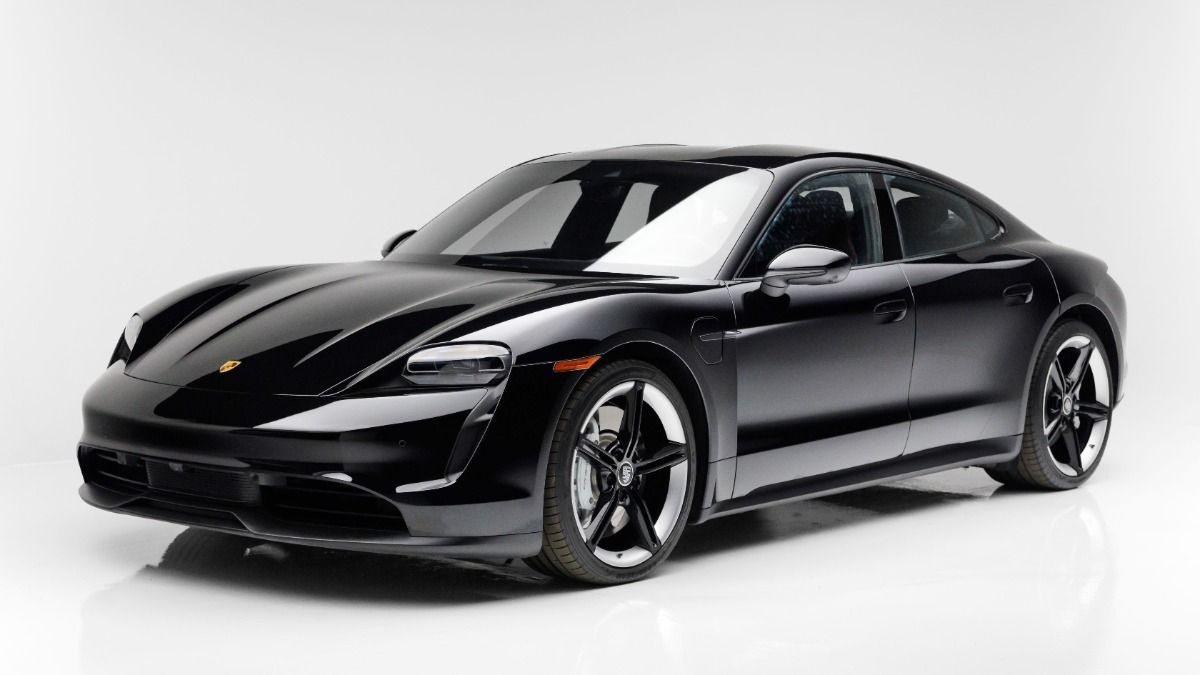
Inside, the Taycan blends Porsche tradition with future-forward design. The driver faces a curved 16.8-inch digital instrument cluster that can be configured to mimic classic Porsche five-dial layouts or minimized for a more focused driving experience.
Sustainable interior options include innovative leather-free materials like Race-Tex microfiber, derived from recycled polyester fibers. The Taycan’s range has expanded to include multiple battery options and body styles, including the more practical Cross Turismo and Sport Turismo variants with increased cargo capacity.
While the EPA-estimated range (between 200-246 miles depending on configuration) lags behind some competitors, real-world testing consistently exceeds these conservative estimates.
True to Porsche’s heritage, the Taycan offers seemingly endless customization possibilities through Porsche Exclusive Manufaktur, allowing buyers to create a truly personalized vehicle.
From custom paint colors to bespoke interior details, the Taycan can be tailored to individual preferences in the same manner as its combustion-powered siblings.
For driving enthusiasts who wish to embrace electrification without sacrificing engagement and character, the Taycan provides a compelling argument that the future of performance can be both sustainable and exhilarating.
6. Audi e-tron GT
The Audi e-tron GT synthesizes striking design, exhilarating performance, and cutting-edge technology into one of the most visually dramatic electric vehicles currently available.
Sharing its platform with the Porsche Taycan (both brands being part of the Volkswagen Group), the e-tron GT infuses this sophisticated architecture with Audi’s distinctive design language and luxury ethos.
The e-tron GT’s low, wide stance and muscular proportions create an unmistakable presence, with a sloping roofline that manages to offer reasonable rear headroom despite its coupe-like profile.
Its aerodynamic optimization is evident in details like the functional air curtains, active rear spoiler, and nearly flat underbody, all contributing to extended range and stability at high speeds.
Performance is delivered through dual permanently excited synchronous motors, producing up to 637 horsepower in the range-topping RS e-tron GT during overboost. This enables a 0-60 mph sprint in just 3.1 seconds, accompanied by a distinctive electric sport sound engineered to provide auditory feedback without mimicking combustion engines.
The advanced 800-volt electrical architecture enables charging from 5% to 80% in approximately 22 minutes at compatible DC fast chargers.
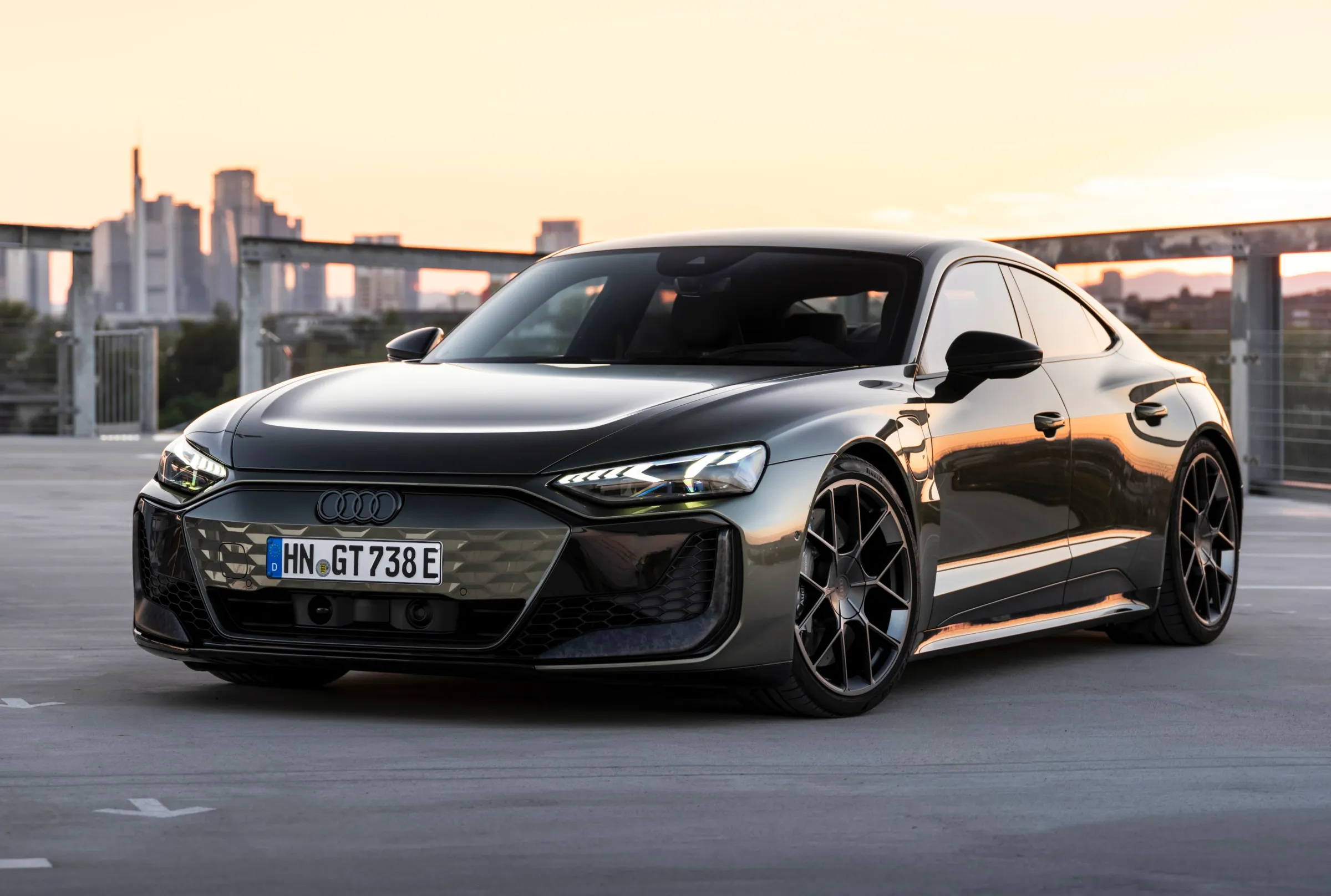
Inside, the e-tron GT offers a driver-focused cockpit that balances digital interfaces with physical controls for critical functions.
The 12.3-inch Virtual Cockpit Plus digital instrument cluster and 10.1-inch MMI touch response system provide crisp information display without the overwhelming screen acreage found in some competitors.
Sustainable interior options include recycled materials and Dinamica microfiber, an eco-friendly alternative to suede.
The standard adaptive air suspension with controlled damping strikes an impressive balance between comfort and handling precision, while available rear-axle steering enhances both low-speed maneuverability and high-speed stability.
The e-tron GT’s brake-by-wire system seamlessly blends regenerative and friction braking, with the ability to recover up to 265 kW of energy during deceleration.
While the EPA-estimated range of approximately 240 miles falls short of some competitors, the e-tron GT compensates with superior charging speed and consistently delivers on its range estimates in real-world driving.
Audi’s comprehensive driver assistance systems include adaptive cruise assist with lane guidance and intersection assist, enhancing both safety and convenience during everyday use.
For buyers seeking a luxury electric sedan with a head-turning design, impressive performance, and a more understated approach to technology integration than some rivals, the e-tron GT delivers a compelling package that remains true to Audi’s progressive luxury philosophy.
7. Genesis Electrified G80
The Genesis Electrified G80 takes a different approach to luxury electric vehicles compared to many of its competitors.
Rather than creating a dedicated EV with futuristic styling that announces its electric nature, Genesis has electrified its established G80 luxury sedan, maintaining its elegant design while replacing the internal combustion powertrain with advanced electric technology.
This strategy results in a sophisticated electric sedan that emphasizes understated luxury and seamless integration rather than technological showmanship.
From the exterior, only subtle cues like the closed G-Matrix pattern grille (which conceals the charging port) and the absence of exhaust outlets hint at the Electrified G80’s zero-emission capabilities.
The familiar Athletic Elegance design language, characterized by the distinctive Two-Line lighting signature and graceful proportions, remains largely unchanged from its combustion counterpart, appealing to traditionalists who prefer classical luxury aesthetics.
Inside, the Electrified G80 features an interior crafted from sustainable materials including forged wood trim created from recycled wood, natural dyes for leather surfaces, and fabrics made from recycled PET plastics.
The cabin maintains the exceptional build quality and attention to detail that has helped establish Genesis as a serious luxury contender, with physical controls for frequently used functions supplementing the 14.5-inch touchscreen.
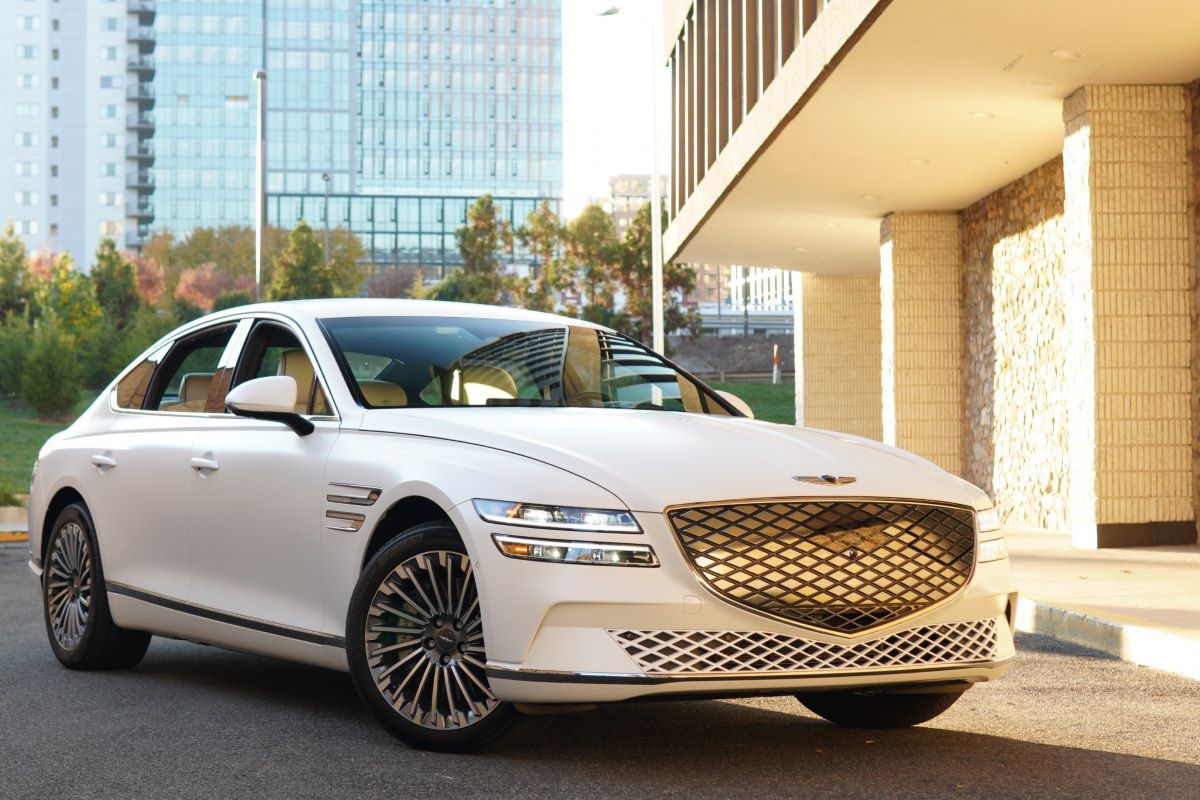
The dual-motor all-wheel-drive system produces 365 horsepower and 516 lb-ft of torque, enabling brisk acceleration from 0-60 mph in approximately 4.9 seconds.
The 87.2 kWh battery provides an EPA-estimated range of 282 miles and supports 350 kW DC fast charging, allowing a 10% to 80% charge in just 22 minutes under optimal conditions.
The standard adaptive suspension with road preview technology uses a front-facing camera to identify upcoming road imperfections and adjust damping accordingly.
Unique features include a Vehicle-to-Load (V2L) function that enables the car to serve as a mobile power source, supplying up to 3.6 kW to power external devices from camping equipment to emergency household appliances during power outages.
The Active Sound Design system allows drivers to select between different soundscapes that respond to driving inputs, enhancing the emotional connection to the vehicle despite the absence of engine noise.
The Electrified G80 exemplifies an evolutionary rather than revolutionary approach to electric luxury, offering a refined alternative for buyers who appreciate traditional sedan proportions and discreet sophistication.
This “electrified” rather than “electric-first” philosophy results in a seamless transition to battery power that maintains the character and strengths of the conventional G80 while eliminating tailpipe emissions.
8. Polestar 2
The Polestar 2 represents a focused interpretation of electric luxury from the performance brand co-owned by Volvo and Geely.
Positioned as a design-forward alternative to established luxury marques, the Polestar 2 combines Scandinavian minimalism with thoughtful engineering and a driver-focused ethos that sets it apart in an increasingly crowded segment.
Unlike traditional three-box sedan designs, the Polestar 2 adopts a distinctive fastback profile with a raised ride height that bridges the gap between sedan and crossover categories.
This approach maximizes interior space and practicality without resorting to the increasingly common SUV format.
The clean exterior design eschews decorative elements in favor of precise surfaces and sharp character lines, complemented by the distinctive “Thor’s Hammer” LED headlights inherited from its Volvo relations.
Inside, the Polestar 2 showcases sustainable luxury with standard WeaveTech upholstery a vegan alternative to leather and reconstructed wood panels that create a warm, inviting atmosphere.
The optional Nappa leather is sourced from Bridge of Weir, which uses environmentally responsible processes and full traceability.
The clean, horizontal dashboard houses an 11.2-inch portrait-oriented touchscreen powered by Google’s Android Automotive OS, offering native integration of Google Maps, Google Assistant, and the Google Play Store.
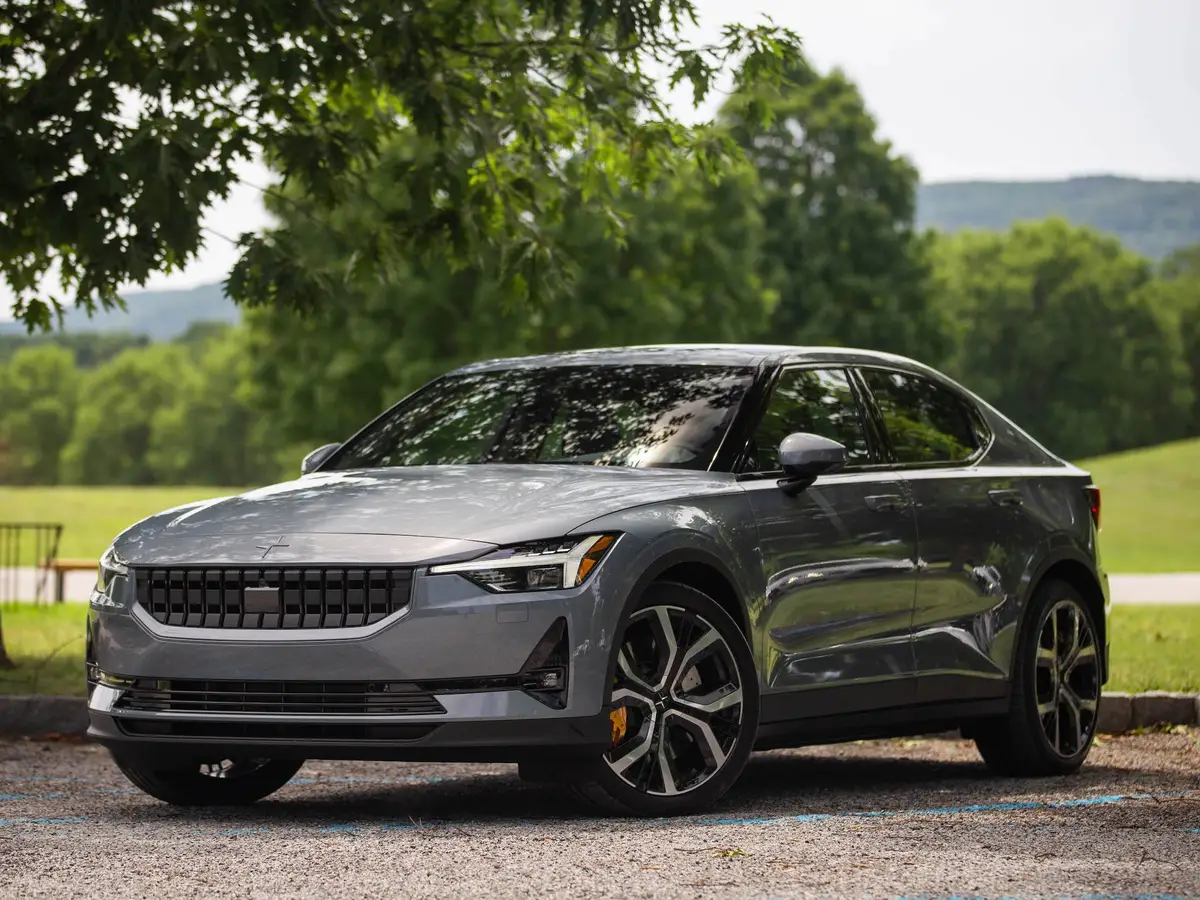
Performance varies by configuration, with the range-topping dual-motor version producing 408 horsepower and accelerating from 0-60 mph in approximately 4.5 seconds.
The single-motor variant prioritizes efficiency, achieving an EPA-estimated range of up to 335 miles with the Long Range battery option.
All versions benefit from a carefully tuned chassis that delivers engaging handling without compromising ride quality, while the available Performance Pack adds Öhlins dampers, Brembo brakes, and gold visual accents.
The Polestar 2’s technological integration extends beyond infotainment to include one of the most comprehensive implementations of one-pedal driving, allowing smooth control without touching the brake pedal in most situations.
The innovative Pilot Assist system combines adaptive cruise control with lane centering and navigation data to deliver a refined semi-autonomous driving experience.
As a brand built around transparency and sustainability, Polestar publishes full life cycle carbon impact assessments for its vehicles and has committed to creating a truly climate-neutral car by 2030.
This values-driven approach, combined with the Polestar 2’s distinctive design and driver-focused character, creates a compelling alternative for buyers seeking a luxury electric vehicle with Scandinavian sensibilities and a clear environmental conscience.
9. Hyundai Ioniq 6
The Hyundai Ioniq 6 represents a bold reimagining of what an electric sedan can be, combining avant-garde streamliner design with exceptional efficiency and technology.
Drawing inspiration from vintage aerodynamic vehicles of the 1930s, the Ioniq 6’s distinctive silhouette achieves a remarkable drag coefficient of just 0.21, rivaling the most slippery production cars ever made and directly contributing to its impressive range and efficiency.
Unlike conventional three-box sedans, the Ioniq 6 features a dramatically sloped roofline that extends nearly to the rear edge of the vehicle, creating a teardrop profile optimized for aerodynamic performance.
This unconventional shape houses a surprisingly spacious interior thanks to the E-GMP platform’s flat floor and extended wheelbase, with rear legroom that exceeds many larger vehicles.
The innovative Parametric Pixel lighting signature comprising over 700 individual LED units throughout the vehicle creates a distinctive visual identity while providing a connection to the digital world.
The Ioniq 6’s interior offers a serene, minimalist environment with sustainable materials including recycled fishing nets, PET bottles, and bio-based elements derived from sugarcane and corn.
The twin 12.3-inch displays form a panoramic screen housing both instrumentation and infotainment, while physical controls remain for frequently used functions.
The completely flat floor creates a living room-like atmosphere, enhanced by relaxation seats that recline during charging stops and 64-color ambient lighting with speed-synchronized modes.
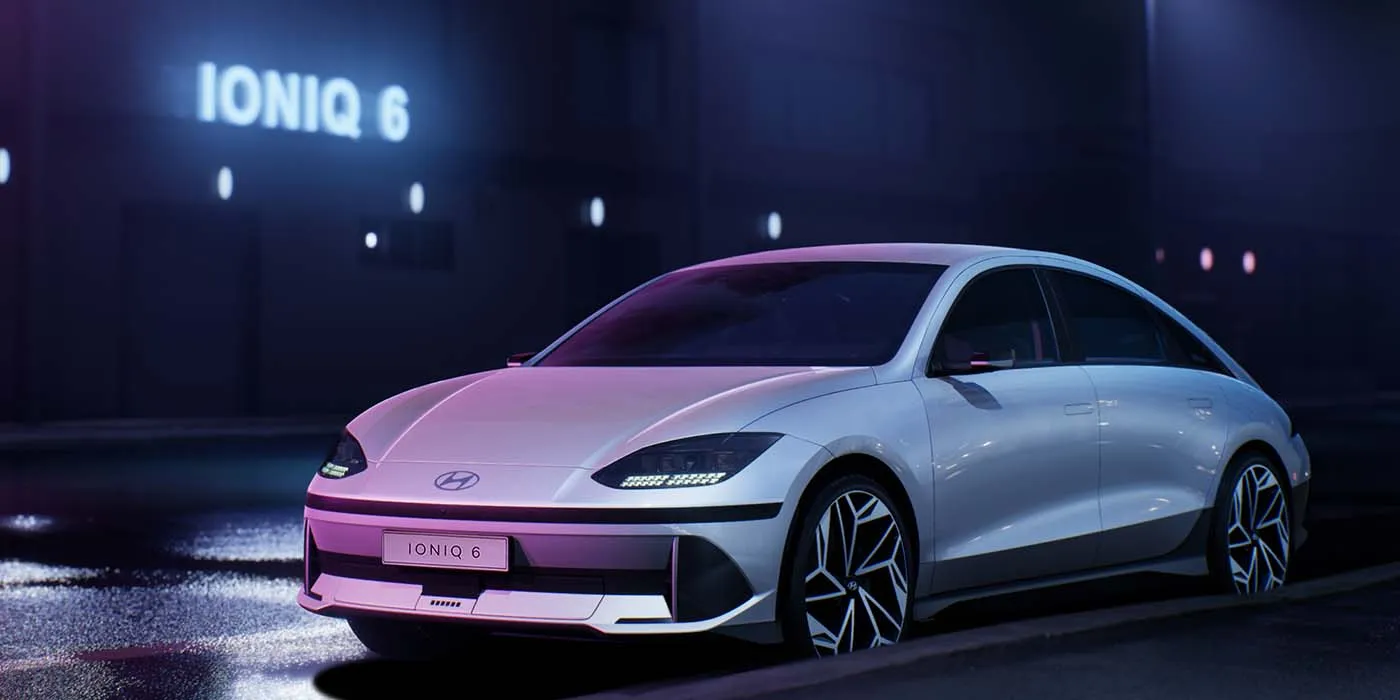
Performance configurations range from the efficiency-focused single-motor version to the dual-motor all-wheel drive variant producing 320 horsepower and accelerating from 0-60 mph in approximately 5 seconds.
The 77.4 kWh battery provides up to 361 miles of range on the WLTP cycle (approximately 340 miles EPA), while the 800-volt electrical architecture enables charging from 10% to 80% in just 18 minutes at compatible DC fast chargers.
The V2L (Vehicle-to-Load) function can supply up to 3.6 kW to power external devices from camping equipment to household appliances.
The Ioniq 6 introduces advanced driver assistance systems including Highway Driving Assist 2 with automatic lane changes and machine learning-based Smart Cruise Control that adapts to individual driving styles.
The Digital Key 2.0 allows secure vehicle access through compatible smartphones or NFC cards, with the ability to share digital keys remotely with friends and family.
By prioritizing efficiency and aerodynamic performance over conventional styling, the Ioniq 6 achieves exceptional range while creating a distinctive presence that stands apart from traditional luxury sedans.
This innovative approach, combined with its competitive pricing, positions the Ioniq 6 as a compelling alternative that redefines expectations for electric mobility.
10. BMW i4
The BMW i4 translates the brand’s sporting sedan heritage into the electric era with a package that remains unmistakably BMW in both appearance and driving dynamics.
Rather than developing a dedicated electric platform, BMW has adapted its flexible CLAR architecture to accommodate battery-electric powertrains, allowing the i4 to maintain proportions and characteristics familiar to enthusiasts of the brand’s conventional models.
Visually, the i4 bears a strong resemblance to the 4 Series Gran Coupe, with the most notable distinction being the enclosed kidney grille that serves as a “technology panel” housing various sensors.
This evolutionary approach to design contrasts with the more radical styling of dedicated EVs, appealing to traditionalists who appreciate BMW’s established design language.
Despite sharing its basic structure with combustion models, clever packaging of the battery pack within the floor maintains interior space while preserving the brand’s characteristic low seating position.
The i4 lineup includes multiple variants, with the range-topping i4 M50 serving as the first electric vehicle developed by BMW’s M performance division.
Its dual-motor setup produces 536 horsepower and accelerates from 0-60 mph in approximately 3.7 seconds, accompanied by a distinctive Hans Zimmer-composed acceleration sound that builds in intensity with speed.
The rear-wheel drive i4 eDrive40 prioritizes efficiency and range, offering up to 301 miles on a single charge of its 81.5 kWh battery.
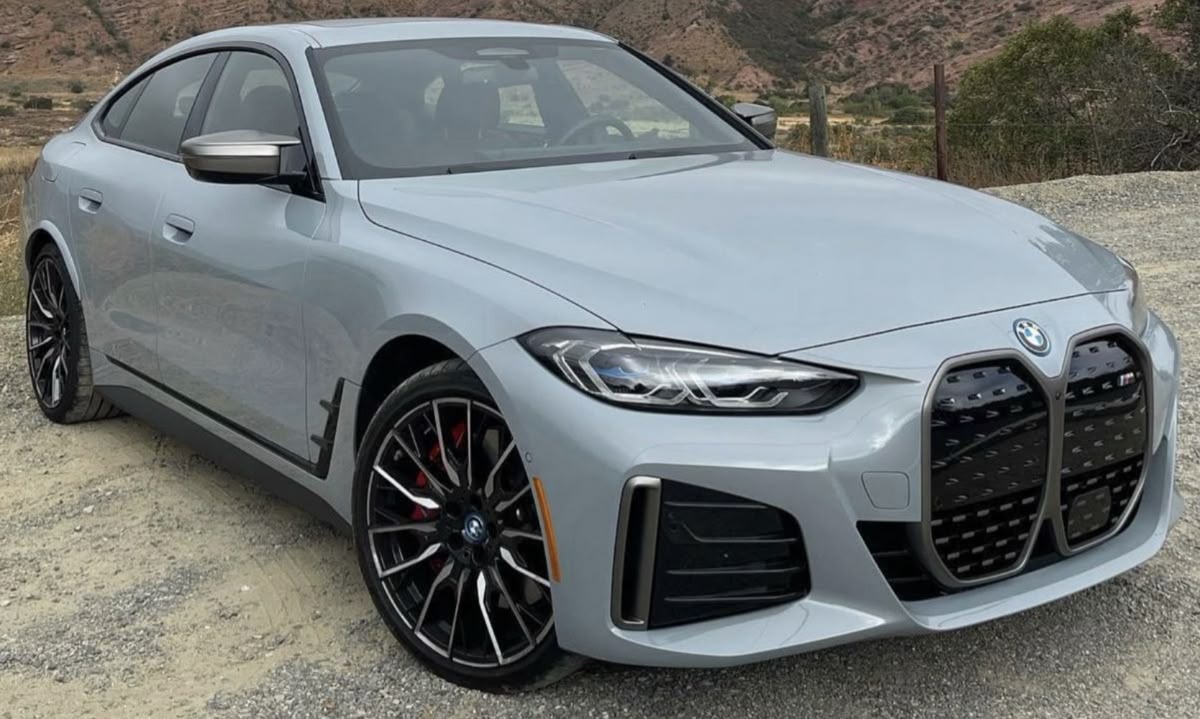
Inside, the i4 features BMW’s curved display, which combines a 12.3-inch digital instrument cluster and a 14.9-inch central touchscreen under a single piece of anti-reflective glass.
The latest iDrive 8 system supports natural language commands and can be controlled via touch, voice, or the traditional rotary controller. A range of interior options includes both traditional leather and sustainable materials like Econell cloth, made from recycled polyester with olive leaf extract tanning.
The i4’s adaptive suspension with frequency-selective damping maintains BMW’s reputation for engaging handling while filtering out road imperfections.
The integrated brake-by-wire system blends regenerative and friction braking seamlessly, with adjustable recuperation levels including an adaptive mode that optimizes energy recovery based on traffic conditions detected by the forward camera.
For BMW enthusiasts looking to embrace electrification without abandoning the brand’s core attributes of driver engagement and sporting character, the i4 provides a compelling bridge between tradition and innovation.
Its balance of performance, efficiency, and familiar BMW dynamics makes it an appealing option for buyers who value driving enjoyment alongside environmental considerations.
11. Nio ET7
The Nio ET7 represents China’s most sophisticated entry into the global luxury electric sedan market, showcasing the country’s rapidly advancing automotive technology with features that rival or exceed established competitors.
As Nio expands its presence in European markets, the ET7 serves as its flagship model, combining impressive performance, cutting-edge technology, and a unique approach to ownership that includes the company’s innovative battery swap infrastructure.
The ET7’s exterior design balances elegant proportions with modern aerodynamic efficiency, achieving a drag coefficient of just 0.23. Its clean surfacing and floating roof design create a sophisticated presence, while flush door handles, streamlined mirrors, and air curtains contribute to both aesthetics and range.
At nearly 16.8 feet long, the ET7 provides generous interior space, particularly for rear passengers a priority in the Chinese market where many luxury vehicles are chauffeur-driven.
Inside, the ET7 presents a minimalist “second living room” concept with sustainable materials including renewable rattan, microfiber, and karuun (a processed rattan material).
The clean dashboard houses a 12.8-inch AMOLED central display and 10.2-inch digital instrument cluster, complemented by a standard augmented reality head-up display.
The cabin features 256-color ambient lighting, a 23-speaker Dolby Atmos audio system, and massage functions for all seating positions. Notably, physical controls remain for frequently used functions, avoiding the all-touch interfaces that can compromise usability.
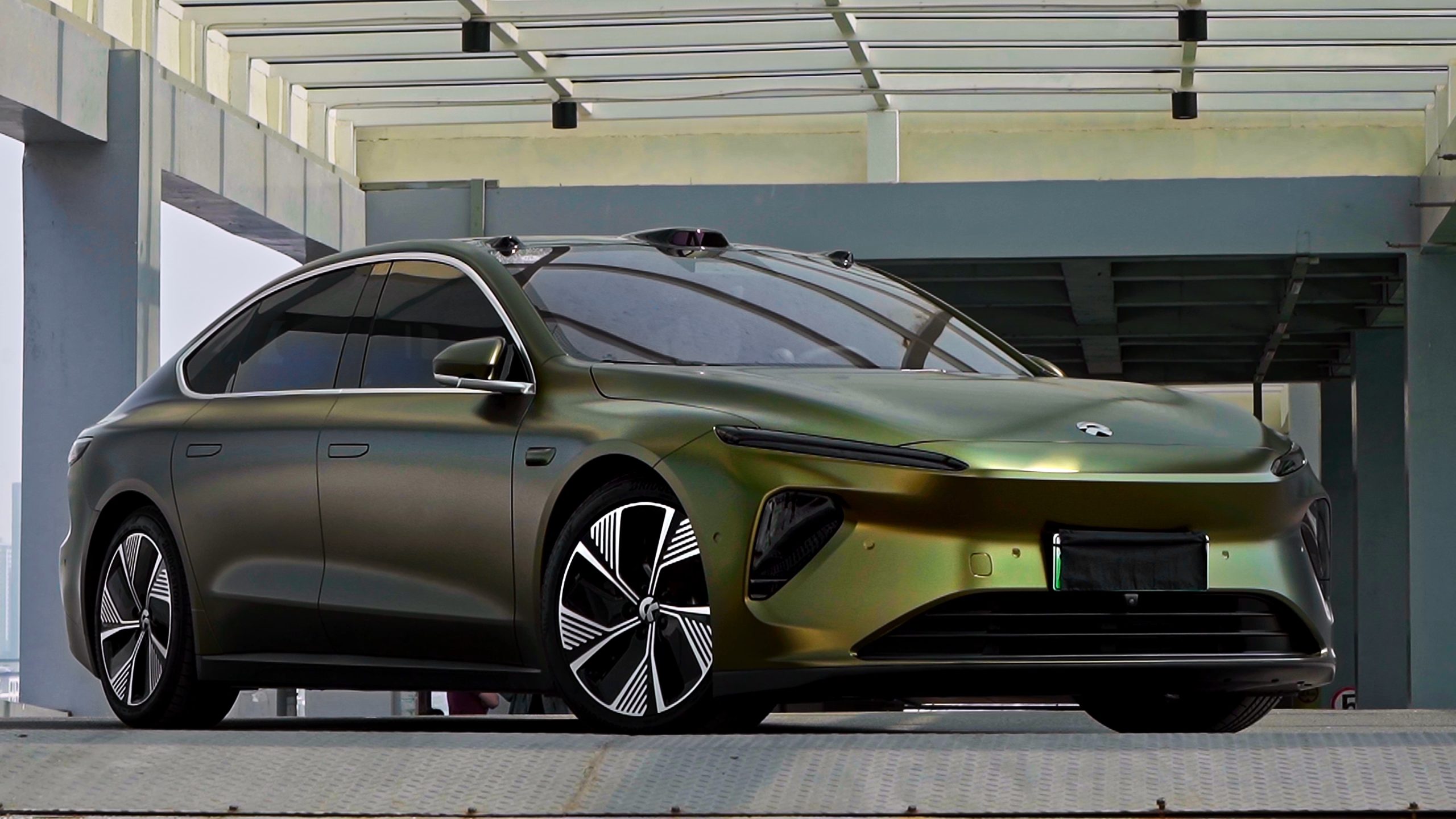
The ET7’s performance credentials are impressive, with dual motors producing 644 horsepower and enabling 0-60 mph acceleration in approximately 3.8 seconds.
Multiple battery options are available, including an innovative semi-solid-state 150 kWh pack offering up to 621 miles of range on the Chinese testing cycle (approximately 550 miles by EPA standards).
Nio’s proprietary battery swap stations can exchange depleted batteries for fully charged ones in under five minutes, providing an alternative to traditional charging for customers enrolled in the “Battery as a Service” subscription program.
The ET7 introduces Nio’s Adam supercomputer, powered by NVIDIA processors and supported by 33 sensing devices including solid-state LiDAR, radar, high-resolution cameras, and ultrasonic sensors.
This hardware supports NAD (Nio Autonomous Driving), which aims to provide advanced driver assistance on highways, urban areas, and automated parking. The vehicle’s software receives continuous over-the-air updates, expanding capabilities throughout ownership.
Nio’s approach extends beyond the vehicle itself to include the Nio House concept combining a showroom, café, co-working space, and forum for owners to create a community around the brand.
While challenges remain regarding global expansion and establishing service networks, the ET7 demonstrates that Chinese luxury EVs have evolved into sophisticated contenders deserving of serious consideration alongside established premium brands.
12. Mercedes-Benz EQE
The Mercedes-Benz EQE translates the innovative features of the flagship EQS into a more attainable midsize package, creating an electric counterpart to the venerable E-Class.
Utilizing the same dedicated electric vehicle architecture (EVA2) as its larger sibling, the EQE offers similar technological sophistication in a more manageable footprint that appeals to driving enthusiasts and urban dwellers alike.
The EQE’s exterior design maintains strong familial ties to the EQS, with its “one-bow” aerodynamic profile and distinctive black panel grille illuminated by the Mercedes three-pointed star pattern.
Though approximately 10.6 inches shorter than the EQS, the EQE offers a longer wheelbase than the conventional E-Class sedan, translating to generous interior space, particularly for rear passengers. The cab-forward design maximizes interior volume within a silhouette that achieves an impressive drag coefficient of 0.22.
Inside, the EQE can be equipped with the optional MBUX Hyperscreen a 56-inch curved glass panel housing three integrated displays that span the entire dashboard. This technological showcase enables intuitive control of vehicle functions while creating a striking visual centerpiece.
Traditional luxury elements like fine leather, genuine wood, and metal accents blend seamlessly with digital displays and advanced ambient lighting that responds to vehicle functions and can be customized to suit different moods.
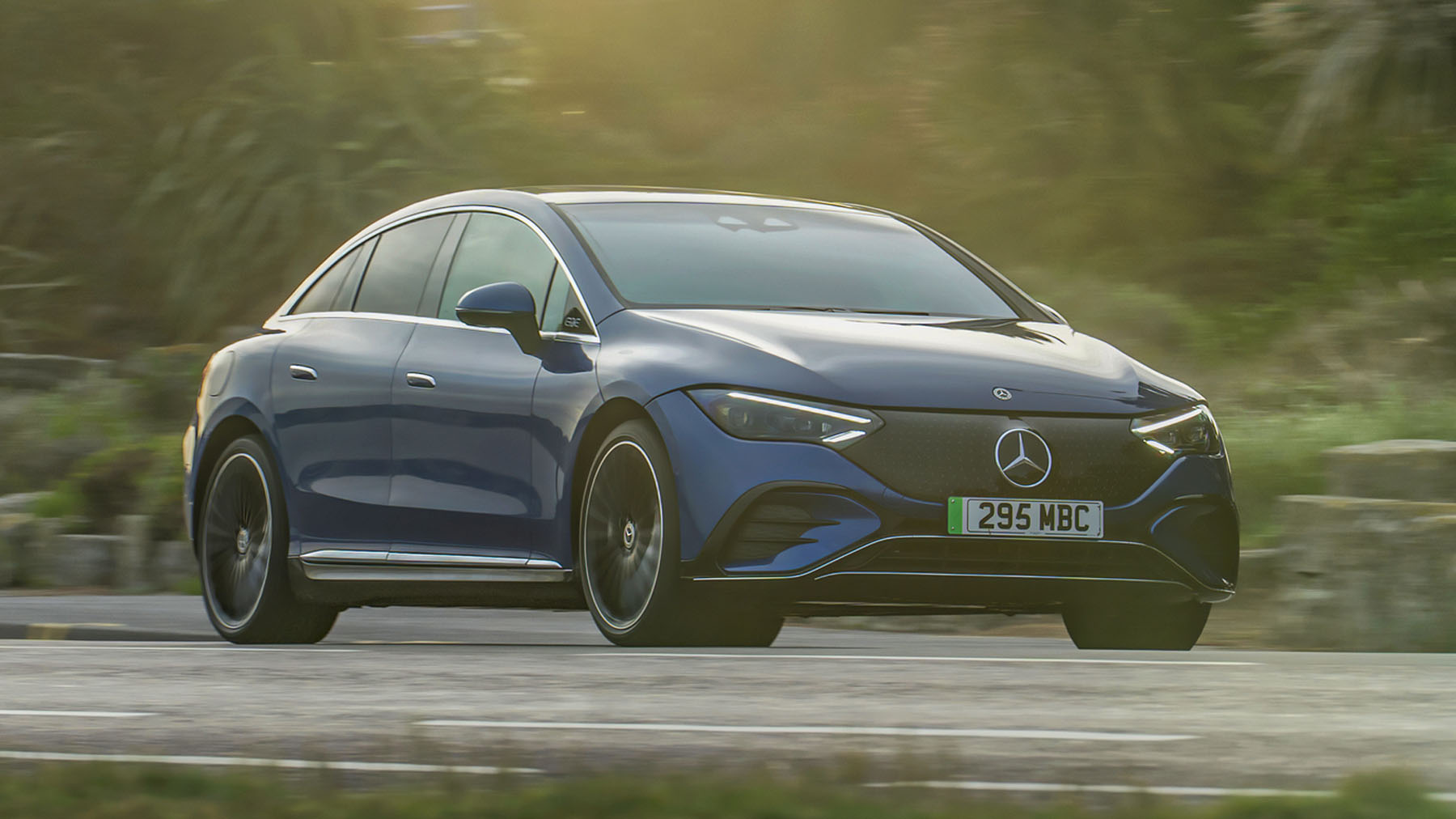
Performance varies by model, with the standard EQE 350 producing 288 horsepower from its single-motor rear-wheel drive configuration, while the range-topping AMG EQE 53 delivers up to 677 horsepower during boost mode from its dual-motor setup, accelerating from 0-60 mph in just 3.2 seconds.
The 90.6 kWh battery provides up to 340 miles of range on the WLTP cycle (approximately 305 miles EPA) and supports DC fast charging at up to 170 kW, adding 186 miles in 30 minutes under optimal conditions.
The EQE introduces several innovative comfort features, including the ENERGIZING AIR CONTROL Plus system with HEPA filtration that removes 99.65% of particles, including viruses and bacteria.
The available Driving Sound Experience creates customizable acoustic feedback that changes with driving mode and acceleration, enhancing the emotional connection to the vehicle despite the absence of engine noise.
Automatic comfort doors can open electronically when the driver approaches and close with a gentle touch of the brake pedal.
Mercedes’ comprehensive driver assistance systems include Attention Assist with microsleep detection, Active Distance Assist DISTRONIC adaptive cruise control, and Active Lane Keeping Assist.
The optional Drive Pilot system prepares the EQE for Level 3 conditional automated driving in jurisdictions where regulations permit, allowing drivers to temporarily hand over control in specific scenarios like heavy traffic at speeds up to 37 mph.
For buyers seeking Mercedes-Benz luxury and technological innovation in a versatile midsize package, the EQE delivers the brand’s electric vision in a more accessible format without significant compromise in features or performance.
Also Read: 12 Classic Cars That Are Popular for DIY Restorations

